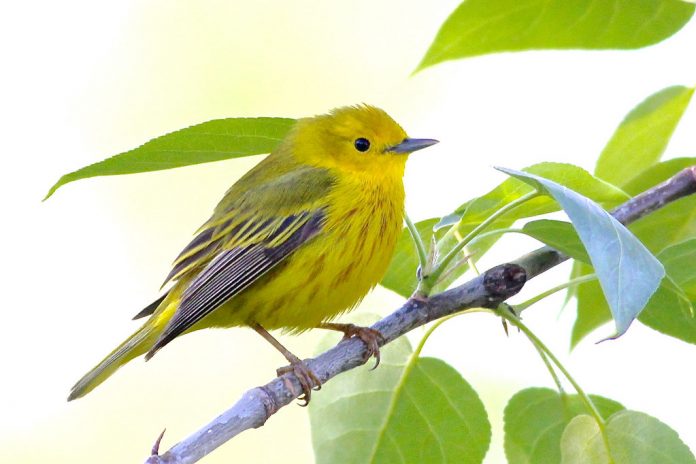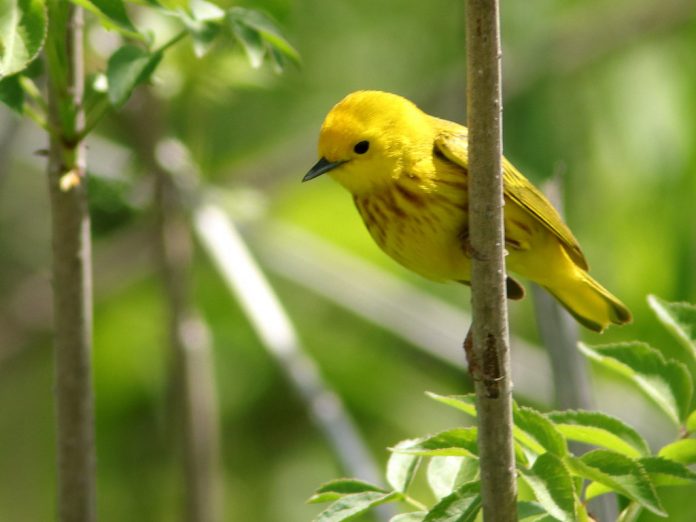Identification: The Yellow Warbler (Setophaga petechia) is a transatlantic vagrant. As the name hints, it is a very yellow bird with vibrant bright yellow on its face and underparts, yellowish-olive upperparts (rump and crown/nape yellower-olive than the mantle and back), and a diffuse yellow eye-ring that highlights dark eyes (but no supercilium). The bird has darker wings with yellowish feather edges and tips to the median and greater coverts, forming rather diffuse, narrow wing bars.
The tail has no white, but, when spread, feathers show noticeably yellow inner webs (most extensive in males); the underside of the tail appears very yellow when viewed from below. The adult male has distinct reddish streaking on the underparts and a much yellower head than the female and is unlikely to be confused. For females and first-winter males, confusion is likely with the female Wilson’s warbler, but the latter has a uniformly dark tail (without yellow).
Moreover, a yellow supercilium is clearly differentiated from the greenish or blackish crown. The plainer wings lack yellow wing bars or feather edges, paler legs, and a slightly more conical, two-tone bill Also, the female Hooded Warbler has striking white outer tail feathers and a greenish crown and nape clearly differentiated from the yellow face, uniformly olive wings (without yellow), and a uniformly dark tail (without yellow).
The female common yellowthroat skulks are low in cover and have yellow restricted to the throat and upper breast plus undertail coverts (oily toned on the latter), brownish flanks, very uniform olive wings (without yellow), and a rounded, uniformly dark tail (without yellow). Yellow is less cover-loving than many other warblers, without restraint perching on tops of bushes, but very active, dropping to feed in the open on the ground and returning to perch, often flicking tail.

Sex/Age: The adult male summer has a deep yellow head and reddish streaking on underparts; the adult male winter is very similar but has a crown and nape-tinged greenish and less distinct reddish streaking below. The adult female is a little duller and paler overall, with a greenish crown or nape and at most faint streaking on the underparts.
The first winters resemble adult females but have tertials more worn, with whitish rather than yellow edges, and less yellow in the tail. The young females were noticeably pale yellow and grayish-olive overall compared with the brighter young males. The latter may show very feeble reddish streaking at the sides of the breast under optimum viewing conditions.
Vocalizations: Yellow Warbler call is a soft but clear ‘chip, ship’; in-flight gives a high, thin ‘zeet’ finished once the male call is ended. The Yellow Warbler song is a clear, lively ‘tseeet-tseet-tseeet- sitta-sitta-seee’ (sometimes rendered’sweet-sweet-sweet-I’m-so-sweet’). Moreover, the hissing calls can be observed during territorial defense. Moreover, yellow warblers have the ability to communicate with posture and touch.
Nest: A female bird actively participates in building a cup-shaped nest with a male in trees. The breeding season is in May and June. While the male bird’s duty is to defend the nest and provide food to the mother and chick, the clutch contains 4 to 6 eggs, rarely below that. The incubation period is about 12 to 14 days. The chicks are brooded for 9 to 10 days and leave the nest in a day or two. It took one year to fully mature.
Size: The yellow warbler is a medium-sized bird about 12.5–13 cm in length with an average weight of about 10–22 grams (can vary).
Habitat: Yellow Warbler is a new world warbler species that is vagrant in Western Europe. In the natural range, it is found in thickets, especially willows or alders near water, bushy open woodland, clearings, hedgerows, garden shrubbery, and also mangroves. Farmlands, shrubland, and forest edges are less preferred; however, densely wooded, suburban, orchards, and parks are preferred areas. The main predators are snakes, birds of prey, raccoons, foxes, feral cats, and many others.
Diet: The Yellow Warbler diet consists of main caterpillars, treehoppers, beetles, mayflies, moths, damselflies, mosquitoes, fruits (berries), and other insects.







